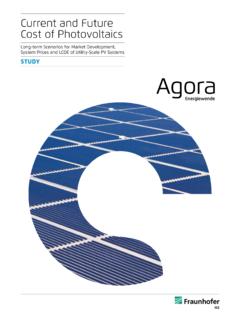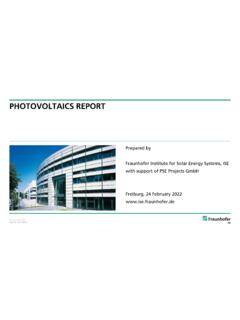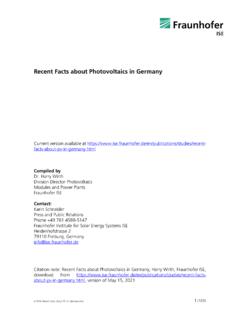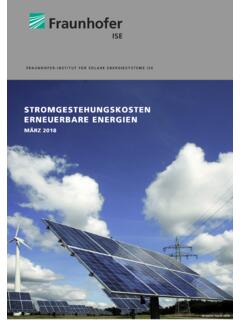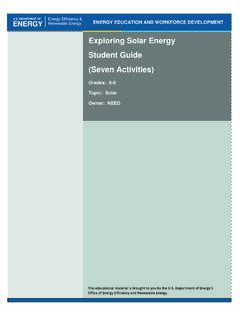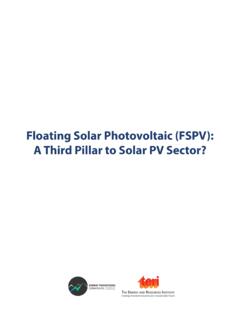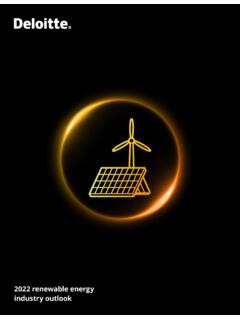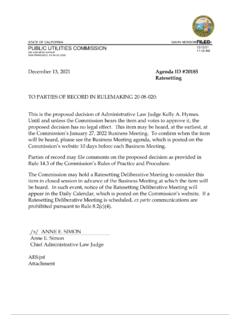Transcription of Study: Levelized Cost of Electricity- Renewable Energy ...
1 01 FRAUNHOFER INSTITUTE FOR solar Energy SYSTEMS ISE Rainer Sturm 2010 Levelized COST OF ELECTRICITY Renewable Energy TECHNOLOGIESJUNE 202102 Levelized COST OF ELECTRICITY Renewable Energy TECHNOLOGIESJune 2021 CHRISTOPH KOST SHIVENES SHAMMUGAMVERENA FLURIDOMINIK PEPERASCHKAN DAVOODI MEMARTHOMAS SCHLEGL FRAUNHOFER INSTITUTE FOR solar Energy SYSTEMS ISE1 Contact Person:Dr. Christoph Institutefor solar Energy Systems ISEH eidenhofstra e 279110 of Institute:Prof. Dr. Hans-Martin Henning Prof. Dr. Andreas BettCONTENTSS ummary 21.
2 Objective of this analysis 62. Historical development of Renewable Energy technologies 93. Input data for the calculation of LCOE 114. LCOE of Energy technologies in 2021 175. Forecast of LCOE up to 2040 in Germany 276. LCOE for renewables in regions with high solar irradiation and favorable wind conditions 317. Excursus: Structural evaluation of added PV systems 348. Appendix 369. References 41 AcknowledgementsWe thank Patrick J rgens, Andreas Bett, Peter Nitz, Matthias Vetter, Johannes W llner, Stephan Lux and Anne Joost for their valuable contribution and great support in creating this study.
3 2 SUMMARYThe present study (2021) compares the Levelized cost of elec-tricity (LCOE) of Renewable Energy technologies for electricity generation with conventional power plants. The future cost ra-tio between the different power generation technologies is also compared for the years 2030 and 2040. For the cost develop-ment of renewables, cost development based on technology-specific learning rates (LR) and market scenarios are focus is on the LCOE of photovoltaic (PV), wind power plants (WPP) and bioenergy plants in Germany. For the first time, PV battery systems are included in the study, as they re-present a growing segment of the German power system mar-ket.
4 As a reference, the development of the LCOE for newly built conventional power plants (lignite, hard coal, combined cycle gas turbines (CCGT), gas turbine) is also examined. Figure 1 shows the LCOE for Renewable and fossil power plants po-tentially built in 2021. Depending on the type of systems and solar irradiation, PV sys-tems have a LCOE between and cent/kWh, exclu-ding value-added tax (VAT). The study distinguishes between smaller rooftop PV systems (< 30 kWp), large rooftop PV sys-tems (> 30kWp), and ground-mounted utility-scale PV systems (> 1 MWp). Currently, specific system costs lie within the range Figure 1: LCOE of Renewable Energy technologies and conventional power plants at locations in Germany in 2021.
5 Specific investments are considered using a minimum and maximum value for each technology. The ratio for PV battery systems expresses PV power output (kWp) over usable battery usable capacity (kWh). 3of 530 to 1600 EUR/kWp. Thus, they have continued to fol-low a decreasing trend, especially for large systems. For smaller rooftop systems, however, a trend towards slightly more ex-pensive systems can be detected. The LCOE for PV battery sys-tems currently range between and cent/kWh. This wide range is the result of cost differences for battery systems (500 to 1200 EUR/kWh) in combination with cost differences for PV systems and varying levels of solar irradiation.
6 In additi-on, battery storage systems can contribute to system security in the electricity system and the stabilization of feed-in curves or battery discharges high demand LCOE of onshore wind power plants in 2021, with specific plant costs ranging from 1400 to 2000 EUR/kW, are between and cent/kWh. As a result, PV systems and onshore wind power plants are, on average, the least expensive techno-logies in Germany, both among Renewable Energy technologies as well as all other power plants. Offshore wind power plants also continue to record decreasing LCOE. With up to 4500 full load hours, offshore wind power plants achieve electricity pro-duction costs between cent/kWh and cent/kWh.
7 The specific plant costs are between 3000 and 4000 EUR/kW, including the connection to the the first time, a distinction was made between biogas and solid biomass in the LCOE of bioenergy. In addition, heat uti-lization was also assumed, which lowers the LCOE. The LCOE of biogas range from to cent/kWh at substrate costs of cent/kWhth. For solid biomass plants, LCOE are slightly lower between and cent/kWh, mainly due to lower substrate costs considered LCOE of potentially newly built coal-fired power plants (hard coal and lignite) have risen considerably due to increased CO2 certificate prices; the LCOE are above 10 cent/kWh.
8 If a lignite-fired power plant were built today, LCOE of to cent/kWh could be expected. The LCOE of large coal-fired power plants are somewhat higher, at between and cent/kWh. The LCOE of combined cycle power plants is somewhat lower at between and cent/kWh. Gas turbine power plants for short-term flexible use land at and cent/kWh. As described above, the decisive factor here is the CO2 price, as the Energy source prices were assumed to be constant due to declining of LCOE in Germany through 2040 Figure 2 shows the results for the future development of the LCOEs in Germany until 2040. The illustrated range reflects the possible cost variations in the input parameters ( power plant prices, solar irradiation, wind conditions, fuel costs, number of full load hours, costs of CO2 emission certificates, etc.)
9 , which are listed in Tables 1 to 6. This methodology is exemplarily explained for the cost range of PV: The upper limit of the LCOE results from the combination of a PV power plant with a high procure-ment price at a location with low solar irradiation ( northern Germany). Conversely, the lower limit is defined by the most inexpensive solar system at locations with high solar irradiation in southern Germany. This same process is carried out for wind and biomass power plants as well as conventional power plants. The usual financing costs on the market and the surcharges for risks are included in detail and are specific to each technology.
10 This provides a realistic comparison of the power plant locations, technology risks and cost developments. The level of financing costs has considerable influence on the LCOE and the competi-tiveness of a technology. Furthermore, all of the costs and dis-count rates in this study are calculated with real values (reference year 2021). Due to the high costs of coal-fired power plants in 2021, the LCOE of these power plant types are not extrapolated for the future, but are at least at the 2021 levels and significantly higher if CO2 certificate prices rise. For PV systems, a learning rate (LR) of 15% is assumed. In 2040, the LCOE ranges from to cent/kWh for small rooftop PV systems and from to cent/kWh for ground-mounted systems.
